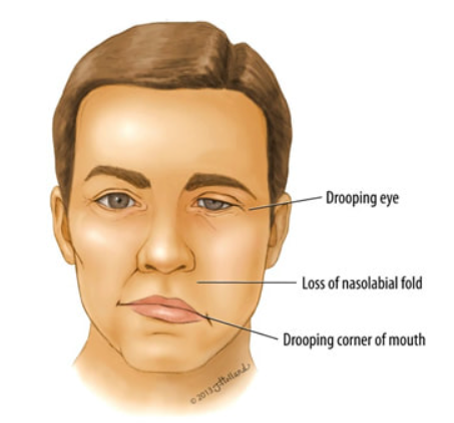Activity 4
Week 3
by GEORGETTE E. ZALDIVAR

This is patient AM, 28-year-old male who came in the ER because of drooping of his left face. He said he woke up and he could not move his left face.
He has no other muscle weakness. He is conscious and coherent although he had a little difficulty speaking because the left side of his lips drooped. He had normal blood pressure and he had no other co-morbidities. He was diagnosed to have Bell’s palsy. Name 5 muscles which are affected and list its actions. Describe the mechanism of his muscle weakness. What other symptoms could the patient exhibit as a result of facial muscle weakness?
Bell’s palsy, also known as acute peripheral facial palsy of unknown cause,is the temporary condition of facial muscle weakness or paralysis, usually occurring on one side of the face. This results from damage to the facial nerve, specifically at the 7th cranial nerve. The muscle weakness causes half the face to droop, smiles to be one-sided, and nasolabial fold to be lost.
Since patient AM was diagnosed with such a facial disorder, he is to suffer from discomfort due to several muscles being affected. The muscles affected by Bell’s palsy and their actions are as follows:
OCCIPITOFRONTALIS (Frontal Belly): draws scalp anteriorly, raises eyebrows, and wrinkles skin of forehead horizontally;
ORBICULARIS ORIS: closes and protrudes lips, compresses lips against teeth, and shapes lips during speech;
BUCCINATOR: presses cheeks against teeth and lips, draws corner of mouth laterally, and assists in mastication by keeping food between the teeth;
PLATYSMA: draws outer part of lower lip inferiorly and posteriorly as in pouting and depresses mandible; and
ORBICULARIS OCULI: closes the eyes, allows the eyes to blink, and controls the tear pump mechanism.
As a consequence of these muscles being affected due to Bell’s palsy, patient AM is expected to suffer from discomfort and other symptoms, such as difficulty in speaking, masticating, and making facial expressions, like smiling. He could also experience pain around the jaw or behind the ear, drooling, downward facial expressions, and occasional headaches.
REFERENCES:
- Mayo Clinic. (2022). Bell's Palsy - Symptoms and causes. Retrieved from Mayo Clinic: https://www.mayoclinic.org/diseases-conditions/bells-palsy/symptoms-causes/syc-20370028
- Tortora, G. J., & Derrickson, B. (2014). Principles of Anatomy and Physiology. John Wiley & Sons, Inc.
- Image from: http://www.microbiologynutsandbolts.co.uk/the-bug-blog/ringing-the-infection-bell-about-facial-nerve-palsy